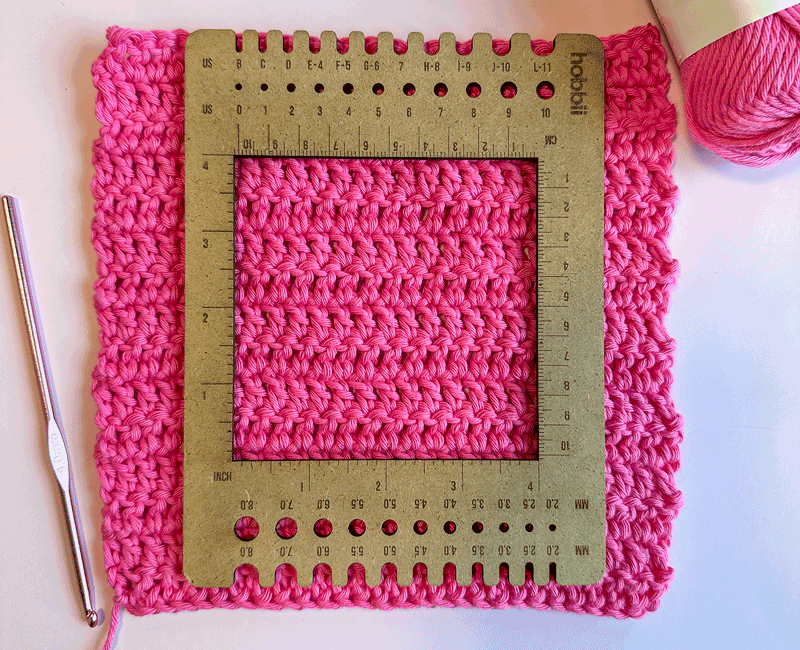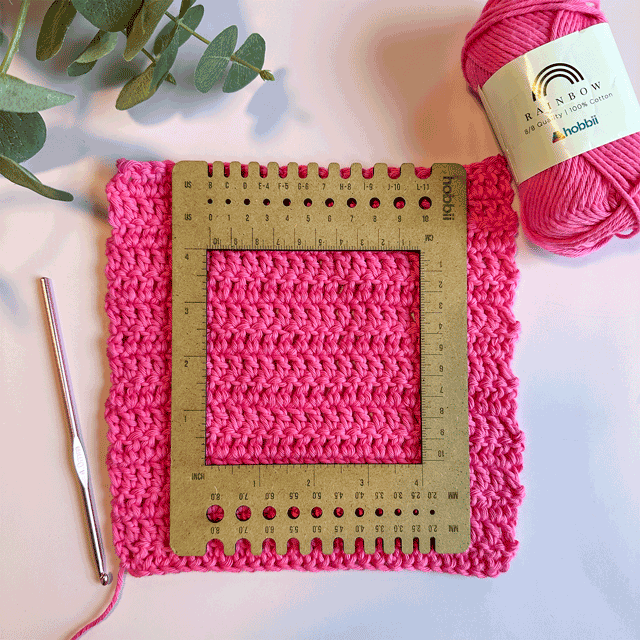Are you unsure how to accurately measure crochet tension, otherwise known as gauge? Don't worry - everyone has been there! In this post, we'll cover the basics of crochet tension and the famous gauge swatch. So grab your crochet hook and let's dive in!

When it comes to getting started on a new crochet project, the gauge swatch is your best friend! Read on and find out why!
In this blog post, we'll explain:
- What is a gauge swatch?
- Why you should bother to crochet a gauge swatch.
- How to crochet a gauge swatch.
- How to measure your crochet tension.
Do you want to skip to the part where we tell you how to do it? Click here.
What Is a Gauge Swatch?
A gauge swatch is essentially a small sample of crochet stitches that will help you to measure the crochet tension of your project.
Why You Should Bother Crochet a Gauge Swatch
It's important to measure crochet tension because it ensures that your crochet projects turn out as expected. Without measuring crochet tension, you risk ending up with pieces that are too small or too big for the pattern you're attempting - oh, the horror!
Plus, crochet tension can help you find the best yarn substitution for a pattern, so it's definitely worth taking the time to measure your crochet tension.
How to Crochet a Gauge Swatch
To crochet a gauge swatch, you will need the yarn and crochet hook that you plan to use for your project. The size of a swatch should be roughly 4” x 4” (10 cm x 10 cm).
The stitches used for your swatch will depend on the crochet pattern you are making. To make sure that your crochet tension is accurate, crochet a few extra stitches and rows than what's specified in the pattern. This ensures that you get an accurate gauge measurement for your project.
If, e.g., you want to make a gauge swatch of double crochets, you can do the following:
- Chain as many stitches as you will need for the swatch. Remember to add the extra chains at the end.
- Add 3 more chains to get enough “height” to start your swatch. Now you are ready to start the actual gauge swatch.
- Make the first double crochet in the 4th chain from the hook. The loop on your hook does not count here. Continue working 1 double crochet in each chain.
- Turn your gauge swatch with 3 chains. These three chains are called the turning chains, tchs, and they are made at the beginning of each new row. Repeat until your gauge swatch is finished.
Chaining tip! Use a hook that is half a size bigger than the one used to crochet your project. That way, the chains won’t be too tight. When starting on the double crochet again, simply switch back to the original crochet hook.

How to Measure Your Crochet Tension
Once you have crocheted your swatch, it's time to measure crochet tension. You will need a ruler or measuring tape to do this.
To measure crochet tension, count the number of stitches and rows in a 4” x 4” (10 cm x 10 cm) area.
You can consider gearing up with a gauge tool. You simply place the frame on top of your project or your crochet sample and then count the number of stitches and rows.
You will then compare your crochet tension to the crochet pattern's crochet tension.
If your crochet tension is larger or smaller than the crochet pattern's crochet tension, you may need to use a different size crochet hook in order to achieve the correct gauge for your project.
When your gauge is too big, you will have to try out a crochet hook in a smaller size. Make a new swatch and see if it's a better fit to match the gauge in the pattern.
When your gauge is too small, replace the crochet hook with a bigger one and crochet a new swatch.
When your gauge matches the pattern, you're good to go! Hurray!
Are your stitches tight and then loose? Read our blog post about how to achieve an even gauge throughout your whole project. You’ll find it here.
